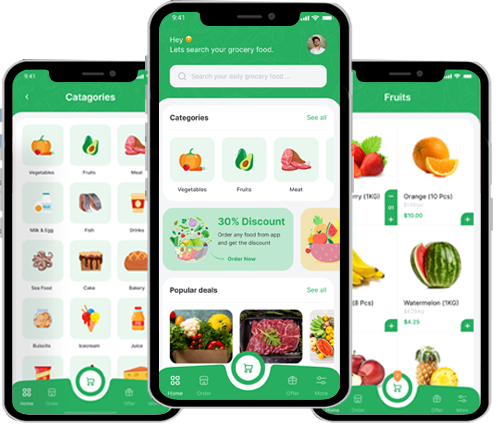How Uber for Grocery Delivery is Changing the Future of Retail
The modern lifestyle demands convenience and efficiency, and grocery shopping is no exception. With the rise of on-demand services, the uber for grocery delivery model has emerged as a game-changer, transforming how people shop for essentials.

The modern lifestyle needs comfort and performance, and grocery shopping is no exception. With the upward thrust of on-call offerings, the Uber for grocery delivery version has emerged as a game-changer, reworking how people save for essentials. This article delves into the concept, advantages, challenges, and future of Uber-like grocery shipping apps, supplying a comprehensive evaluation for organizations and clients alike.
What is Uber for Grocery Delivery?
The time period Uber for grocery delivery refers to a commercial enterprise version that applies the ideas of Uber's experience-hailing carrier to grocery delivery. It connects clients with nearby grocery stores or non-public shoppers via a cellular app, allowing them to order groceries and have them delivered fast to their doorstep. These apps are powered by using actual-time monitoring, advanced algorithms, and a seamless personal interface to ensure an easy and green reveal.
How Does It Work?
Customer Browsing: Users download the app, browse a list of partnered shops, and select the gadgets they need.
Order Placement: Once the cart is finalized, the order is placed, and the fee is made via included charge gateways.
Order Fulfillment: A delivery companion or non-public consumer is assigned to choose up and supply the order.
Real-Time Tracking: Customers can music their orders in actual-time, from order processing to transport.
Delivery Completion: The delivery accomplice ensures that the groceries are introduced immediately to the client's vicinity.
Benefits of Uber-Like Grocery Delivery Apps
1. Convenience for Consumers
Gone are the days of spending hours in crowded grocery stores. With just a few taps, customers can order groceries from the consolation in their houses, saving effort and time.
2. Real-Time Tracking
These apps offer actual-time updates, allowing users to track the popularity of their orders and estimate shipping instances appropriately.
3. Wide Range of Choices
Customers can get admission to more than one store, evaluate costs, and pick out merchandise that fine meets their needs, imparting greater variety than a single bodily save.
4. Business Growth for Retailers
Local grocery shops benefit from extended visibility and accelerated purchaser reach, driving extra income without the need for good-sized marketing investments.
5. Employment Opportunities
These structures create jobs for shipping personnel and private consumers, contributing to an economic boom.
Features of a Successful Grocery Delivery App
1. User-Friendly Interface
An intuitive app layout ensures that users of every age can navigate through the platform's effects.
2. Advanced Search and Filters
Customers can quickly discover their desired merchandise through the usage of clever search alternatives and filters.
3. Real-Time Order Tracking
Integrated GPS monitoring keeps customers informed about the reputation of their orders.
4. Secure Payment Options
Multiple fee gateways, along with credit/debit playing cards, virtual wallets, and coins-on-delivery, decorate user convenience.
5. Push Notifications
Notifications hold users up to date on gives, order confirmations, and shipping updates.
6. Customer Support
24/7 support ensures that any issues or queries are addressed promptly
Challenges in Implementing the Model
1. Logistics Management
Coordinating with a couple of shipping companions and stores may be complicated and calls for sturdy logistical making plans.
2. Maintaining Product Quality
Ensuring the freshness and excellence of perishable gadgets during delivery is a critical task.
3. High Competition
With mounted gamers like Instacart and Amazon Fresh, new entrants face stiff opposition.
4. Cost Management
Balancing operational fees, including delivery prices and driving force repayment, whilst retaining charges aggressive can be tough.
5. Customer Retention
Providing regular providers with high-quality and unique features is vital to preserving customers in a highly aggressive marketplace.
Future of Grocery Delivery Apps
1. Integration of AI and Machine Learning
Advanced technology can personalize personal studies, optimize shipping routes, and expect customer possibilities.
2. Eco-Friendly Practices
Sustainable packaging and electric shipping cars will play a massive position in reducing the environmental impact of those services.
3. Expansion into Rural Areas
As internet penetration grows, grocery shipping apps will make bigger their reach to underserved rural markets.
4. Subscription-Based Models
Offering subscription plans with blessings like unfastened delivery and one-of-a-kind discounts can pressure consumer loyalty.
5. Voice and AI Assistants
Integration with voice assistants like Alexa or Google Assistant can make ordering groceries even greater seamless.
Conclusion
The Uber for grocery app version is reshaping the grocery corporation, providing unprecedented convenience for clients and new boom possibilities for organizations. While there are stressful conditions to conquer, enhancements in the era and client-centric improvements promise a shiny future for this quarter. For organizations, making funding in a sturdy grocery delivery app can pave the way for lengthy-time period success in a more and more virtual global.
FAQs
1. What is an Uber-like grocery delivery app?
It is a platform that connects clients with grocery shops or private consumers, permitting them to order groceries and have them brought to their doorstep, just like Uber's ride-hailing model.
2. How do grocery delivery apps make cash?
These apps generate sales through delivery costs, carrier prices, subscription plans, and commissions from partnered stores.
3. Are grocery delivery apps safe to use?
Yes, maximum apps use stable price gateways and follow strict hygiene protocols to make certain secure deliveries.
4. Can small grocery shops gain from such apps?
Absolutely. Partnering with shipping apps increases visibility and consumer reach, riding more income for neighborhood stores.
5. What are a few popular grocery delivery apps?
Examples encompass Instacart, Amazon Fresh, Shipt, and Walmart Grocery. Businesses also can expand custom apps tailored to particular markets.
By embracing the Uber for grocery delivery model, we are able to look forward to a future in which grocery buying is not only faster but also greater green and patron-friendly.
What's Your Reaction?



















